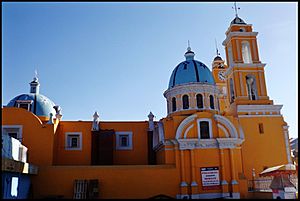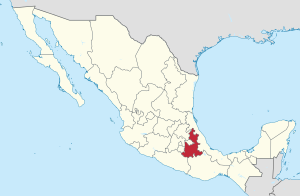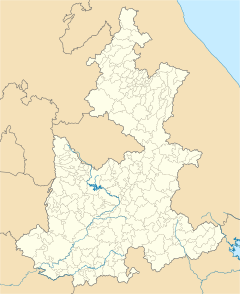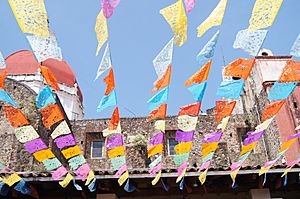San Salvador Huixcolotla facts for kids
Quick facts for kids
San Salvador Huixcolotla
|
|
|---|---|
|
Municipality and town
|
|

Parroquia del Divino Salvador (Church of the Divine Savior) in the center of San Salvador Huixcolotla
|
|

Location of Puebla State in Mexico
|
|
| Country | |
| State | Puebla |
| Area | |
| • Total | 23.909 km2 (9.231 sq mi) |
| Elevation | 2,040 m (6,690 ft) |
| Population
(2010)
|
|
| • Total | 12,148 |
| Time zone | UTC-6 (Central Standard Time) |
| • Summer (DST) | UTC-5 (Central Daylight Time) |
San Salvador Huixcolotla is a town and municipality in the state of Puebla, Mexico. It is well-known as the place where Papel picado became very popular. The name San Salvador means "Holy Savior" in Spanish. Huixcolotla comes from the Nahuatl language and means "place of the curved spines."
Contents
A Look at Huixcolotla's Past
The first people to live here spoke Popoloca. They were part of the powerful Aztec Triple Alliance. In 1539, a small church group was started by Friar Juan de Rivas. This happened during the Spanish colonization.
Later, in 1750, work began on the Iglesia del Divino Salvador, which means "Church of the Divine Savior." The area officially became a town in 1779. On April 15, 1930, it was named a municipality. This happened when Leonides Andrew Almazán was the governor.
Exploring the Geography of San Salvador Huixcolotla
San Salvador Huixcolotla covers an area of about 23.9 square kilometers (9.2 square miles). Most of this land, about 79%, is used for farming. The other 21% has buildings and other developments.
The town has four main neighborhoods, called barrios:
- El Calvario
- San Antonio
- San Martín
- La Candelaria
There are also three smaller areas called colonias:
- San Isidro
- Dolores
- Benito Juárez
The municipality is surrounded by other towns. To the north are Los Reyes de Juárez and Acatzingo. To the east are Acatzingo and Tecamachalco. To the south are Tecamachalco, Tochtepec, and Cuapiaxtla de Madero. To the west are Cuapiaxtla de Madero and Los Reyes de Juárez.
Understanding the Climate
The temperature in San Salvador Huixcolotla usually stays between 12 and 18 degrees Celsius (54 to 64 degrees Fahrenheit). The area typically gets about 1100 to 1300 millimeters (43 to 51 inches) of rain each year.
Life in San Salvador Huixcolotla
In 2015, almost all homes in the area had electricity and good sanitation systems. About half of the homes, 50.10%, had running water inside. It's great to know that most young people, about 90.25% of those aged 6 to 14, know how to read and write.
The Art of Papel Picado
Papel picado is a beautiful Mexican folk art. Its name means "perforated paper" or "pecked paper." It involves cutting detailed designs into sheets of tissue paper. This art became very popular in San Salvador Huixcolotla.
People believe this art started from an old practice. Before the Spanish arrived, people made religious offerings using amate bark paper. Some of the first known papel picado artists were Juan Hernandez, Cristóbal Flores, Santiago Vivanco R., and Lauro Pérez Macías.
By the late 1920s, papel picado had spread beyond Puebla to Tlaxcala. Today, it is used all over the world. It is a big part of Día de Muertos (Day of the Dead) celebrations. In Huixcolotla, Día de Muertos is also known as Todos Santos. This art is also made for other important celebrations. These include Semana Santa (Easter's Holy Week), Mexican Independence Day, and Christmas.
In 1998, the governor of Puebla recognized the town's importance. They declared papel picado from Huixcolotla a cultural heritage of the state. About 35% of the people living in the town are involved in making this special craft. Papel picado from Huixcolotla is even sent to other countries. It is often shown through the Museo Nacional de Arte.
Other Cultural Traditions
The town celebrates its patron saint, San Salvador, with an annual fair. This fair takes place from August 6 to 14. A famous local dish is mole poblana. This rich sauce is a specialty of the Puebla region.



